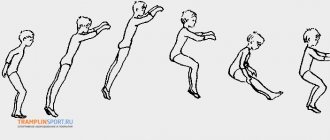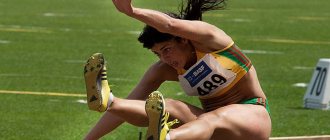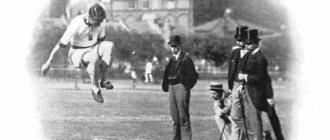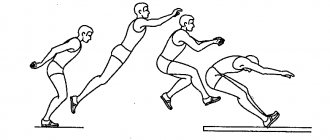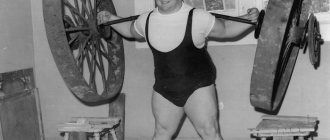Verified jumping records
The authoritative data on the records are as follows:
- 3.73m - world record;
- 3.48m - a record for Russia and the CIS;
- 3.47m - Olympic record;
- 4.08m is a non-existent record.
Now let's look at the victories in order.
World standing jump record
373 cm is the world record for standing jump, set by Byron Jones. The record was recorded on February 23, 2015 by an NHL representative at the Scouting Combine, which was held from February 17 to 23, 2015 at Lucas Oil Stadium in Indianapolis.
The record is based on official data published on the National Hockey League website (nfl.com).
The athlete surpassed the mark of 3.71 meters set by Norwegian shooter Arne Tvervaag from the Ringerike FIK sports club in 1968. Norway is famous for its jumping records because it is the only country where standing long jump has become a national sport.
Defender of the Fatherland Day is a good day for world records, although the athlete is from the USA. We invite you to watch the video of the world record:
CIS record for standing long jump
The Russian and CIS standing jump record is 348.2 cm and belongs to the Georgian athlete Dmitry Melitonovich Ioseliani, set on October 26, 1936 at the age of 23. The jump height was 1.63 meters.
From the age of 17, the Honored Master of Sports of the USSR was famous for his sporting achievements. With two running steps, Dmitry jumped 1.90 meters in height.
Olympic standing long jump record
347 cm is the Olympic standing long jump record, which belongs to the American athlete Ray Urey. He managed to jump 347 cm from a standstill and 1.65 meters in height.
It so happened that standing long jump was included in the Olympic list only from 1900 to 1912. Looking at the results of the games in 1900, 1904 and 1908, you can see that Rei Yuri really had a special talent and defeated his opponents out of competition, with a margin of more than 5 cm.
This was a list of officially recorded records. But what about 4 meters and 8 cm? Wait, let's figure it out.
False standing jump record
The Internet knows another record for standing jumps - 408 cm, set by a certain Chen Hsi Ping in 2010. This record can at least be called unconfirmed, if not completely false.
The current world record belongs to Chinese athlete Chen Hsi Ping, who jumped 4 meters 8 centimeters in Beijing in January 2010. The record was witnessed by 15,000 spectators and participants of the sports festival.
As they say, no matter what you do, there will always be an Asian who can do it better than you.
, But:
- The world Internet does not know such an athlete as Chen Hsi Ping. Not to mention official sources. There are Chen Long and many other outstanding athletes and none named Chen Hsi Ping;
- Information about such an event is compiled in a template manner and without reference to specific reliable data;
- No matter how much you search for videos and photos of Chen Hsi Ping’s jumps, you won’t find anything. And even in Chinese.
Therefore, you should not believe false information about 408 cm, which is not supported by any data. If you know anything about this record, write a comment.
Nadia Comaneci: gymnastics, 45 years old
Until the 1976 Olympics, no gymnast had ever scored a perfect 10. As part of the gymnastics competition, every gymnast who competed in Montreal that year was required to include a compulsory portion.
Romania's Nadia Comaneci performed the required portion of her routine so flawlessly that she scored the first ever perfect 10. It was so unprecedented that the scoreboards could not display her results. Instead they showed 1.00.
Comaneci isn't the only gymnast to score a perfect 10. Once the barrier was overcome, judges began to award them more and more often. At the 1980 Moscow Olympics, nine gymnasts scored a perfect 10 points. In 1984, Los Angeles had 44 maximum 10s. In 1988, there were 28 more.
The judges realized that the situation was getting out of control and became much stricter. In 1992, only two gymnasts received the maximum 10 points. After that it didn't happen again.
We also recommend reading: The most interesting culinary delicacies
And in 2006, the scoring system was changed to an assessment in two categories. A system where gymnasts are graded based on difficulty and execution. Since the difficulty score has no upper limit, it makes a perfect result impossible. This means Comaneci's record will likely stand forever.
History of development
Athletics (running long jump, marathon distances, hammer throwing, javelin and other types of exercises) became an effective impetus for the development of sports as a whole.
The first standing long jump record was set back in Ancient Greece, when this exercise was usually performed with dumbbells in hands. Additional weights typically ranged from 2 to 10 pounds. The result of jumping in such a situation depended on how effectively the person swung the dumbbells. The athlete had to push off and carry the weights so that at the moment of flight, the legs and arms were located in front of the body. The active movement of the arms just before landing freed the dumbbells, thereby significantly increasing the flight distance.
Most of the time, Greek athletes honed their styles of performing the exercise; they did not need a record in the standing long jump. Therefore, you will not be able to find specific data on the strength indicators established at that time anywhere.
Florence Griffith-Joyner: Women's 100m, 33
At the 1988 Olympics in Seoul, South Korea, Florence Griffith-Joyner became a legend not once, but twice. Not only did Flo-Jo, as she was known, have a flamboyant style. She demonstrated legendary athletic performance.
When she took to the track to run the women's 100m, the Olympic record belonged to one of her competitors, Evelyn Ashford. Who ran it in 10.97 seconds in 1984.
Flo-Jo immediately outpaced her opponent, running in 10.88 seconds on her first try. But Ashford then equaled that time, maintaining her share of the record.
Undaunted, Flo-Jo set a new record in the quarterfinals, running it in 10.62 seconds. Incredibly, she improved her time to an incredible 10.49 in the final. But this result was not counted as an Olympic record. Not only that, but Flo-Jo's record still stands 33 years later.
Jamaican runner Shelley-Ann Fraser-Pryce ran the 2022 race in 10.63, the fastest time recorded since Flo-Jo.
She ran the course faster than 60 of the 101 male athletes in the same event.
We also recommend reading: What dog breeds are the smartest?
Standing long jump record
Few exercises in great sports can be compared to movements that are natural to humans. But jumping belongs to this group, which is why they became part of international competitions back in the period of Ancient Greece.
When the standing jump was included in the program of student competitions at Oxford University in 1860, Mike Powell became the winner, showing a result of 5.28 m. But this was only the beginning of his rapid career.
On August 30, 1991, Mike Powell set a phenomenal record in the standing long jump, which no one has yet been able to break. He managed to jump a distance of 8.95 m.
The first women's record was recorded back in 1928 thanks to the efforts of Japanese representative Kinue Hitomi, but it was broken more than once by other athletes, and now the record is 7.52 meters.
Ilona Slupianek: women's shot put, 41 years old
East Germany's Ilona Slupianek remains a controversial Olympic figure. Slupianek began her Olympic career in 1976 under her maiden name Ilona Shknecht. Then, in 1977, she tested positive for illegal substances. And for a short time she was banned from playing sports altogether.
When her suspension was lifted, she had enough time to qualify for the 1980 Olympics in Moscow. And it was then, 41 years ago, that she set an Olympic record in the shot put at 22.41 meters. And this is an Olympic record that still stands to this day.
Some suspect Slupianek used her suspension to take as many drugs as possible. Before returning to the Olympic stage.
The East German government has implemented a secret doping regime since 1974. State sponsored, which required all their Olympians to use these substances.
The East German government not only injected steroids into its Olympians, but also helped them evade detection. Carrying out hormonal therapy and even supplying clean urine for testing. It seems very unlikely that Slupianek was expelled after her suspension. But we'll probably never know for sure.
Standing long jump
Standing long jump is a simple physical exercise that even children can do. The main role in it belongs to a fast and stable run-up, as well as a powerful push. While flying, it is also important to maintain balance and land correctly.
Long jumps allow you to develop speed and strength indicators: in order for the muscles to start working in an “explosive” mode, it is necessary to apply a lot of force in a short period of time. During the exercise, the muscles of the anterior thigh (quadriceps), gluteal muscles, foot and lower leg muscles, as well as spinal extensor muscles are involved.
Long jumps are used both for general physical development and as an “aid” to improve results in other exercises, such as barbell squats. Jumping is often included in the complex training of track and field athletes, wrestlers, boxers and other athletes.
Types of long jump
There are several options for performing the exercise:
Jumps are carried out according to the same principle, but have their own characteristics. For example, when jumping from a place, you need to choose the right starting point (take-off point).
Competition rules
The athlete’s task is to achieve the greatest horizontal length of the running jump. Long jumps are held in the horizontal jump sector according to the general rules established for this type of technical event. When performing a jump, athletes in the first stage make a run-up along the track, then push off with one foot from a special board and jump into a pit with sand. The jump distance is calculated as the distance from a special mark on the take-off board to the beginning of the hole from landing in the sand.
The distance from the take-off board to the far edge of the landing pit must be at least 10 m. The take-off line itself should be located at a distance of up to 5 m from the nearest edge of the landing pit.
Long jump sector Getting on the take-off board
Standing long jump technique
Proper execution of the exercise ensures the athlete’s safety and helps avoid injury. The following phases of the standing long jump are distinguished:
1. Preparation before pushing off. Accepting the starting position is an important stage, as it allows you to concentrate and gather all your strength. The initial phase here is the starting line.
- Stand at the starting point, place your feet shoulder-width apart;
- Move your arms slightly behind your back, bend your elbows and lower them down;
- Bend your legs at the knee and hip joints, position the first ones at the level of your socks;
- Do not lift your feet off the ground, fix the position.
2. Repulsion. Produced immediately after preparation. You can’t linger, because you won’t be able to jump further. This is due to the fact that at the first stage the body begins inertial movement.
- Make a sharp lunge forward with your arms;
- Tighten the hip joints;
- Straighten your knees;
- Lift off the ground abruptly.
3. Flight and landing.
- Stretch your body in a straight line, smoothly straighten your knees;
- Before landing, lower your arms and bring your feet forward;
- Land carefully on the ground, bending your knees slightly to maintain balance;
- Straighten up when landing.
There are two important rules that help you jump as far as possible: you need to keep your body at an angle of 45 degrees and you cannot land on straight feet and legs.
Technique for performing a standing triple long jump
This exercise is included in the track and field competition program. It works like this:
1. Push off with two legs and fly. The athlete’s actions are similar to those needed for a classic standing long jump.
- Throw yourself out in front of you with one leg bent at the knees. The lower leg is lowered and looks slightly forward;
- The second leg serves as a delay at the back;
- As you land, bring your other leg forward to prepare for the next phase.
Common mistakes
Many athletes perform long jumps incorrectly. The most common mistake is a spade. It consists of crossing the line intended for the push. Another mistake is making a jumping jump. There is a widespread belief among beginners that for some reason you need to jump on both feet before jumping directly. Another error is the small amplitude of hand movements. In this case, you need to practice your swings, otherwise you will end up with a high jump rather than a long jump. If we eliminate these shortcomings, the length of the jump will immediately increase by several centimeters.
To achieve good results, you need:
- monitor all movements and avoid their inconsistency. This often results in confusion between the limbs;
- do not step behind the starting line;
- do not lower your legs, especially at the very end of the landing;
- fully straighten your limbs;
- try not to fall or roll over on your side when in contact with the surface.
How to improve your standing long jump?
To achieve stable positive dynamics, you need to train regularly. In summer this can be done outdoors, in the cold season - in an equipped gym. Before training, a 15-minute warm-up is required. Thanks to it, the muscles will become toned, and the risk of injury will be significantly reduced.
Improving the standing long jump involves performing other exercises. To strengthen the leg muscles, squats with a barbell, presses, and deadlifts are useful. To easily and simply group, you need to do planks, push-ups and pull-ups. They will help strengthen your abdominal and back muscles. Much attention needs to be paid to aerobic exercise, which involves the heart and respiratory system. Such training is aimed at improving endurance.
To increase your long jump distance, follow these simple rules:
- strictly follow the technique of performing the exercise;
- strengthen your core muscles using loads;
- run more, while running, raise your hips as high as possible and pull your knees to your chest;
- practice other types of jumps;
- do muscle stretching exercises;
- track your progress.
Long jump is a difficult exercise. There is no need to immediately chase high performance. In the beginning, it is important to master the correct technique and bring it to automaticity. It may not be as fast as you want, but after regular training, results will definitely appear.
World long jump record 8.95m
Holy shit, no one has jumped over it in 24 years
That's another thing. There was a Georgian in the USSR, Dmitry Ioseliani. In 1930, he set a world record for standing jumps. 3,482 meters.
Although no one is particularly involved in standing jumps anymore, no one has yet been able to break this record.
At school I jumped 2.7, now 3.15m, before I only did running, now I do nothing. Should I train to break the record? =)
We are used to jumping over the border.
No. This guy devoted half his life to training to become the best in the world.
What have you achieved with your pale skin? I'm guessing 3k MMR?
this is so powerful
